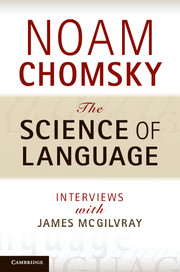Book contents
- Frontmatter
- Contents
- Introduction
- Part I The science of language and mind
- 1 Language, function, communication: language and the use of language
- 2 On a formal theory of language and its accommodation to biology; the distinctive nature of human concepts
- 3 Representation and computation
- 4 More on human concepts
- 5 Reflections on the study of language
- 6 Parameters, canalization, innateness, Universal Grammar
- 7 Development, master/control genes, etc.
- 8 Perfection and design (interview 20 January 2009)
- 9 Universal Grammar and simplicity
- 10 On the intellectual ailments of some scientists
- 11 The place of language in the mind
- 12 Chomsky's intellectual contributions
- 13 Simplicity and its role in Chomsky's work
- 14 Chomsky and Nelson Goodman
- Part II Human nature and its study
- Appendices
- Commentaries
- Glossary
- Bibliography
- Index
8 - Perfection and design (interview 20 January 2009)
from Part I - The science of language and mind
Published online by Cambridge University Press: 05 June 2012
- Frontmatter
- Contents
- Introduction
- Part I The science of language and mind
- 1 Language, function, communication: language and the use of language
- 2 On a formal theory of language and its accommodation to biology; the distinctive nature of human concepts
- 3 Representation and computation
- 4 More on human concepts
- 5 Reflections on the study of language
- 6 Parameters, canalization, innateness, Universal Grammar
- 7 Development, master/control genes, etc.
- 8 Perfection and design (interview 20 January 2009)
- 9 Universal Grammar and simplicity
- 10 On the intellectual ailments of some scientists
- 11 The place of language in the mind
- 12 Chomsky's intellectual contributions
- 13 Simplicity and its role in Chomsky's work
- 14 Chomsky and Nelson Goodman
- Part II Human nature and its study
- Appendices
- Commentaries
- Glossary
- Bibliography
- Index
Summary
JM: I want to ask some questions about the ‘perfection’ of the language faculty. First, a background matter: if you speak of perfection and in particular perfection in design of the language faculty – or at least, the mapping to the SEM interface – you seem to be invited to answer the question, “design for what?”
NC: I think that's misleading. That's because of connotations of the word design. Design suggests a designer, and a function of the designed thing or operation. But in biology, ‘design’ just means the way it is.
JM: The structure, whatever it is . . .
NC: How is the galaxy designed? Because the laws of physics say that that's the way it's designed. It's not for anything, and nobody did it. It's just what happens under certain physical circumstances. I wish there were a better word to use, because it does carry these unfortunate connotations. In a sense – a negative sense – there's a function. If the structure were dysfunctional, it wouldn't survive. And OK, in that sense, it's designed for something. It doesn't mean it's well designed for survival. So take language and communication. Language is poorly designed for communication, but we get by with it, so it's not dysfunctional enough to disappear [or at least, disappear with regard to its use for communication, which isn't its only use, by any means]. Take, for example, trace erasure [or in the more recent terminology of copies, non-pronunciation of copies]. It's good for efficiency of structure, but it's very bad for communication. Anyone who tries to write a parsing program [encounters it] . . . most of the program is about how to find the gaps. Where are the gaps, and what's in them? If you just repeated – if you spelled out [or pronounced or otherwise exhibited] copies – the problem would be gone. But from a computational point of view, that would be poor design, because it's extra computation, so there's no point in it. So you cut it out. And there's case after case like that. So take garden path sentences and islands, for example. Islands prevent you from saying things you would like to say. You can't say, “who did you wonder why visited yesterday.” It's a thought; you know what it means.
- Type
- Chapter
- Information
- The Science of LanguageInterviews with James McGilvray, pp. 50 - 58Publisher: Cambridge University PressPrint publication year: 2012



